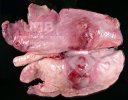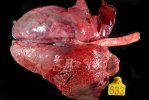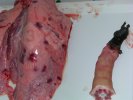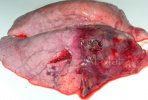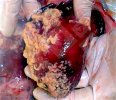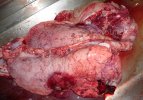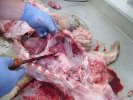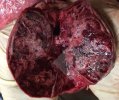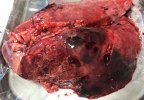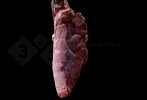
Laboratory diagnostics: Actinobacillus pleuropneumoniae (APP)
What laboratory diagnostic methods can I use to APP? Which one should I choose according to the situation? How do I interpret the results?
The pig sector events all around the world
Weekly newsletter with all the pig333.com updates
Swine industry news in your email
Pig health: news and articles on PRRS, PCV2, biosecurity, etc, Pig disease guide, atlas of pathology, clinical cases…
Biocheck.UGent is an independent, risk-based, scientific scoring system for assessing the quality of your on-farm biosecurity.
A visual and practical step-by-step guide on how to perform a necropsy on a pig.
All the information about ASF: how to recognize the disease, how it is transmitted, pictures of lesions, latest news, guides, etc.
All the information on Foot and Mouth Disease in pigs: how to recognize the disease, how it is transmitted, images of lesions, latest news, guides,...
Description of the most important diseases and conditions in pigs
Images of major swine diseases
Pig disease diagnostic tool
Definition for the most commonly used pig terms
Simulator that calculates the amount of drug to add to the water when using a flow dispenser.
Weekly newsletter with all the pig333.com updates
Pig Prices by countries. Pork production and trade. News of the pig market and the raw materials
The latest slaughter pig prices in the most important pig markets. Check the evolution of the historical prices in charts and in several currencies.
Latest quotations for the main commodities used in pig feed. Historical graphs with the pig price and estimated feed price.
Figures & trends in pig numbers, pork production and pork trade.
Global production and trade data for the most important raw materials
Weekly newsletter with all the pig333.com updates
Articles on nutrition and pig feeding, characteristics of raw materials and additives for pig feed. Prices of raw materials
Latest quotations for the main commodities used in pig feed. Historical graphs with the pig price and estimated feed price.
Technical sheets of the main raw materials and additives used in swine feed. They include a comparison of nutritional values from various sources, product
Global production and trade data for the most important raw materials
Definition for the most commonly used pig terms
Use this tool to diagnose problems with the feed conversion ratio. Click on the flowchart or on the buttons within the text to navigate through the different parts of the tool.
A biweekly newsletter with the latest developments in swine nutrition
Articles on genetics and pig reproduction: genetic improvement, genomics, artificial insemination, use of hormones
Compare production data, calculate the number of sow, nursery, and finishing spaces, and visualize your tasks on the work schedule by type of BMS.
Tool that allows you to calculate the replacement rate in your farm
Definition for the most commonly used pig terms
Use this tool to find out why your farrowing rate is less than ideal. Click on the flowchart or on the buttons found within the text to navigate through the different parts of the tool.
Weekly newsletter with all the pig333.com updates
Management, pig farm management, work planning in each production stage: management in gestation, grow finish, batch farrowing
Compare production data, calculate the number of sow, nursery, and finishing spaces, and visualize your tasks on the work schedule by type of BMS.
Tool that allows you to calculate the replacement rate in your farm
Definition for the most commonly used pig terms
Weekly newsletter with all the pig333.com updates
Design of facilities and equipment for pig farms: building design, climate control, feeding systems, etc.
Biocheck.UGent is an independent, risk-based, scientific scoring system for assessing the quality of your on-farm biosecurity.
Environmental Footprint Calculator along the pork value chain.
Definition for the most commonly used pig terms
Simulator that calculates the amount of drug to add to the water when using a flow dispenser.
Use this tool to explore which slurry management strategy best fits your situation. Click on the flow chart or on the buttons within the text to navigate through the different parts of the tool.
Weekly newsletter with all the pig333.com updates
List of the most important diseases and conditions in pigs. Symptoms, causes, diagnosis, control and prevention of each disease are described. Some of the treatments mentioned may be prohibited in some countries. Information on all diseases to be completed in the coming days.
Pleuropneumonia is a disease of bacterial origin with a high respiratory impact. The production of toxins can often cause sudden death with nasal hemorrhage.
The Actinobacillus pleuropneumoniae (App) bacteria, has at least fifteen different serotypes, some of which do not produce any clinical signs, while others may cause serious disease. The serotypes vary depending on the country. Serotypes 1,2,5,9 and 11 are normally quite virulent, while serotypes 3 and 7 are quite mild. The App is transported in the tonsils and the upper respiratory tract. It is transmitted in short distances through aerosol and only survives outside the pig for a few days.
The organism may affect the pig from weaning to slaughter, but normally it affects pigs 8 to 16 weeks old. The incubation period is very short; as short as 3 hours. The toxins produced by the bacteria can cause severe pulmonary damage. Infected animals can carry the organism during several months without showing any symptom.
App is not very common in sows, unless they did not had previous contact, or unless the subclinical disease is triggered by coinfections, especially PRRS or influenza.
All ages
Based on the farm history, clinical signs, post mortem examination including slaughterhouse exams and culture of the organism. Pulmonary lesions are very typical. Serology may be used to identify serotypes, but its interpretation can be difficult due to cross reactivity between serotypes.
App must be differentiated from Actinobacillus suis infections, enzootic pneumonia, PRRS, influenza, and pneumonia caused by Salmonella choleraesuis.
Due to the acute course of the disease, in new outbreaks it is important to identify the clinical cases quickly and mass inject the entire group of pigs as quick disease progression can make difficult identifying affected animals. The infected pigs stop eating and/or drinking, so medicating trough feed or water is not an adequate treatment method. App is sensitive to a wide range of antibiotics.
It is important to determine the time the outbreak can take place and administer strategic medication and prevention plans.
In acute outbreaks, the population at risk should be examined three times a day in order to identify the disease as soon as possible. There are several vaccines available. These vaccines should include the specific strain of the outbreak.
Select replacement animals from herds negative to App.

What laboratory diagnostic methods can I use to APP? Which one should I choose according to the situation? How do I interpret the results?


